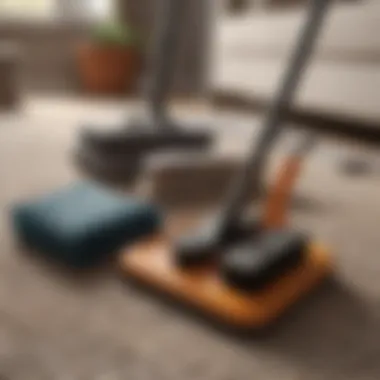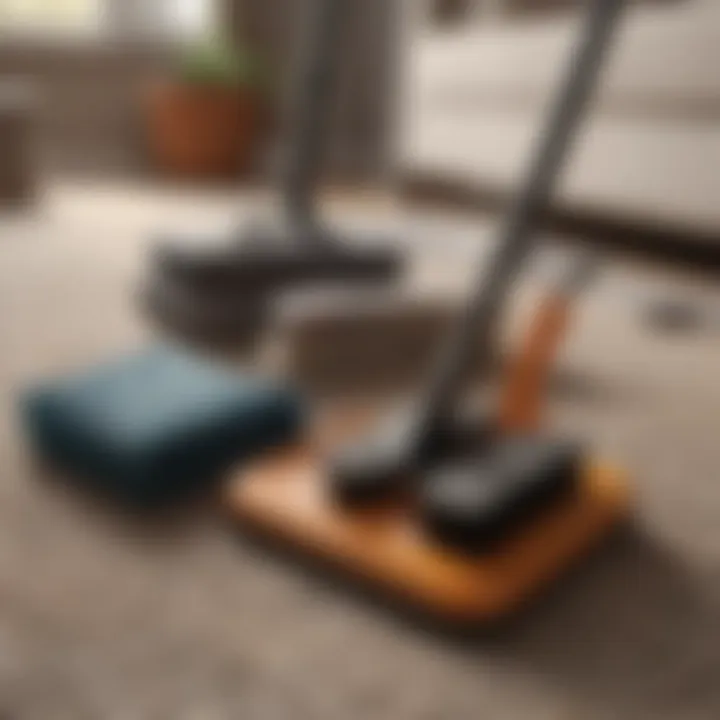Expert Guide to Cleaning a Large Rug at Home


Intro
Cleaning a large rug at home is not merely a task; it is a necessary careful process that enhances the beauty and longevity of your flooring. While many may neglect this essential chore, the impact of a clean rug on a room's overall aesthetic cannot be understated. The right cleaning methods ensure that your rug not only looks good but also remains in good condition, avoiding damage that could be caused by improper handling. This guide aims to illuminate the various steps, techniques, and tools necessary for effectively cleaning large rugs at home, making the once daunting task much more manageable.
Essential Tools for Rug Cleaning
Before delving into the cleaning process, it is crucial to gather the right tools that will aid you in achieving desired results. Here are some essential items you will need:
- Vacuum Cleaner: A vacuum is indispensable for removing loose dirt and dust before any deep cleaning begins. Make sure it is suitable for rugs.
- Stiff-Bristle Brush: This is useful for agitating dirt affected by foot traffic.
- Rug Cleaning Solution: Choose a product that suits your rug's material. Solutions vary for wool, synthetic, and natural fibers.
- Water Hose: For rinsing out the cleaning solution, a gentle spray or hose can help.
- Towels: These will help to absorb excess water after cleaning.
With these tools at your disposal, you can efficiently tackle the cleaning process.
Preparing the Space for Cleaning
A clean and organized space is essential when cleaning a large rug. To prepare, follow these recommendations:
- Clear the Area: Remove furniture and other objects from the rug to provide ample space for cleaning.
- Inspect the Rug: Examine for stains, wear, or any areas needing special attention. This prevents further damage during cleaning.
- Test the Cleaning Solution: Always test the cleaning product on a small, inconspicuous area of the rug to ensure it does not alter the color or texture.
"Proper preparation makes all the difference in effective cleaning of large rugs."
Cleaning Techniques
The main cleaning methods generally revolve around two primary techniques: dry cleaning and wet cleaning.
Dry Cleaning Method
- Vacuum Thoroughly: Ensure all debris is removed.
- Apply Dry Cleaning Powder: Spread the carpet powder evenly across the rug's surface. Let it sit for the recommended time as per manufacturer instructions.
- Brush the Rug: Use a stiff-bristle brush to agitate the powder. This helps lift dirt and odors.
- Vacuum Again: Once the powder has settled, vacuum thoroughly to remove any residues.
Wet Cleaning Method
- Pre-Wet the Rug: Lightly mist the surface with water to open fibers.
- Mix Solution: Combine your chosen cleaning solution with water according to instructions.
- Scrub with Brush: Apply the mixture with the brush, working gently in circular motions. Target stains or spots carefully.
- Rinse: Use a hose to rinse away the cleaning solution thoroughly, ensuring no residue remains.
Drying Process
The drying phase is critical to avoid mold or mildew. Here are some tips:
- Air Dry: Position the rug in a well-ventilated space, preferably outdoors under shade.
- Towel Drying: Use towels to absorb excess moisture before air drying.
- Avoid Direct Sunlight: Prolonged exposure can fade colors and damage fibers.
Maintenance Tips
To retain the beauty and quality of your rug in the long run, consider the following maintenance practices:
- Regular Vacuuming: Make vacuuming a routine to keep dirt at bay.
- Rotate Rug: To ensure even wear from foot traffic, rotate the rug every few months.
- Spot Clean Stains Promptly: Tackle spills immediately to prevent stains from setting in.
- Professional Cleaning: Every few years, seek professional cleaning to maintain the rug’s integrity and aesthetic.
In summary, cleaning a large rug at home does not have to be overwhelming. With the correct tools and techniques, you can effectively enhance the appearance and longevity of your rug, making it a cherished element of your home decor.
Foreword to Rug Cleaning
Rug cleaning is a crucial aspect of maintaining a clean and inviting home. Rugs often serve as focal points in living spaces, contributing to the overall aesthetic and comfort of a room. However, they also accumulate dust, allergens, and stains, which can affect their appearance and even the air quality in your home. This article explores the essential steps in cleaning and caring for large rugs, ensuring that they remain beautiful and functional for years to come.
Importance of Regular Cleaning
Regular cleaning is not merely about aesthetics; it plays a vital role in prolonging the life of your rug. Dust mites, dirt, and other particles can accumulate over time, leading to wear and tear. By implementing a routine cleaning schedule, you can preserve the integrity of the fibers and prevent damage. Additionally, keeping your rug clean enhances your indoor air quality, as rugs can trap dust and allergens that might otherwise circulate in the air.
Understanding Rug Materials
Rugs come in various materials, each with unique characteristics that affect cleaning methods and care requirements. Understanding these materials can guide you in selecting the appropriate cleaning techniques to avoid damage.


Natural fibers
Natural fibers include wool, cotton, and silk. These materials are often appreciated for their durability and luxurious feel. Wool, for instance, is known for its resilience, making it a popular choice for high-traffic areas. Its unique structure allows it to repel dirt and stains, simplifying the cleaning process. However, it’s essential to use gentle cleaning methods to avoid damaging the fibers. Natural fibers can absorb moisture, which makes them susceptible to mold and mildew if not dried properly after cleaning.
Synthetic fibers
Synthetic fibers such as nylon and polyester are widely used due to their affordability and stain resistance. These materials are generally easier to clean than natural fibers. For example, nylon rugs often feature moisture-resistant properties that make them less prone to wear from spills. However, they can sometimes show dirt more visibly than natural rugs, requiring more frequent cleaning. Synthetic rugs are less likely to suffer damage from harsh cleaning agents, but it is still advisable to choose products that are suitable for their specific material.
Mixed materials
Preparing to Clean the Rug
Cleaning a large rug requires careful planning and preparation. Taking time to prepare can enhance the efficiency of the cleaning process and ensure that the rug remains undamaged during cleaning. Pre-cleaning preparations involve identifying the right location for cleaning, gathering necessary supplies, and understanding the specific requirements associated with the rug material. Ensuring a well-thought-out approach not only saves time but also achieves a more effective clean.
Choosing the Right Location
Outdoor vs. indoor cleaning
When deciding between outdoor and indoor cleaning for your rug, understanding the characteristics of each environment is essential. Cleaning outdoors often allows for better ventilation and natural sunlight, which can help in the drying process. This can also reduce the risk of moisture retention, which may lead to mold growth.
However, outdoor cleaning can come with drawbacks, such as exposure to dirt from the environment or poor weather conditions. Indoor cleaning, on the other hand, can offer a controlled space. It keeps the rug safe from external pollutants, but might limit airflow and increase drying time. Weighing the pros and cons helps in making an informed decision based on your setup and rug condition.
Space requirements
Space is another vital element when cleaning a big rug. Ensure that there is ample room to maneuver the rug. Large rugs need sufficient space for rolling out and access to all sides. Crowded spaces can complicate the cleaning process and may risk damages.
A clear, spacious area will enable you to work faster and provides ease during the cleaning process. If indoors, consider moving furniture or clearing a section where you can spread out the rug. If cleaning outdoors, ensure there’s enough flat space to lay the rug down safely without the risk of it getting damaged by rough surfaces.
Gathering Necessary Supplies
Vacuum cleaner
A vacuum cleaner is an indispensable tool when preparing to clean a rug. It removes dust, dirt, and debris from the surface, making the subsequent cleaning steps more effective. Opting for a vacuum specifically designed for rugs can ensure that you cover a variety of rug materials without causing damage.
Choosing a vacuum with sufficient suction power will ensure that it can delve deep into the fibers of the rug. It is also wise to consider a vacuum with multiple attachments to clean different areas efficiently. However, be cautious that not all vacuum cleaners are equally effective for this task; using an unsuitable model can lead to wear and tear.
Cleaning solutions
The right cleaning solutions are crucial to achieving a deep clean without harming the rug's material. Choosing a solution designed for your rug type will reduce the risk of discoloration or damage. Many cleaning solutions are available, including eco-friendly options that provide a gentle yet effective clean.
Always perform a spot test on a small area of the rug first, ensuring no adverse reactions occur. This practice will guide you in selecting the appropriate cleaning method tailored to your specific needs. Finding the right balance can lead to a more satisfying cleaning result.
Brushes and cloths
The effectiveness of cleaning will often depend significantly on the tools used, and brushes and cloths are essential. A soft-bristled brush is ideal for shaking loose dirt while minimizing the risk of damaging the fibers. For spot cleaning, having microfiber cloths at hand can help absorb water and cleaning solution efficiently.
It is important to select materials that will not scratch or harm the rug. Quality brushes and cloths will enhance your cleaning efforts, allowing for thorough dirt removal and effective stain treatment while preserving the texture of the rug. The right tools streamline the process and contribute to effective maintenance.
Vacuuming the Rug
Vacuuming is a crucial step in the rug cleaning process, one that should not be overlooked. Regular vacuuming helps to maintain the rug's appearance and prolong its life. This action removes dust, dirt, and debris that settle into the fibers over time. Without frequent vacuuming, these particles can accumulate, leading to potential wear and tear, and even mold growth in certain conditions. A clean rug not only looks better but also improves indoor air quality by reducing allergens.
Techniques for Effective Vacuuming
Direction of vacuuming
The direction of vacuuming greatly affects the cleaning process. Vacuuming in the direction of the fibers can help lift dirt and dust more efficiently. This technique ensures that the vacuum cleaner can penetrate the fibers deeply, extracting particles that are often missed when vacuuming against the grain. Choosing the right direction is a beneficial strategy to enhance the effectiveness of your cleaning routine.
One unique feature of vacuuming in the appropriate direction is its capacity to maintain the rug’s pile. If you consistently vacuum against the fibers, you may inadvertently flatten them, making the rug appear worn much sooner than expected. Thus, understanding this direction in vacuuming is essential for preserving the rug's aesthetic appeal.


Frequency of vacuuming
The frequency of vacuuming holds significance in maintaining hygiene and appearance. Rug owners should aim to vacuum high-traffic areas at least twice a week, while less frequented areas can be vacuumed less often. This regularity is essential to prevent dirt from settling into the fibers and causing damage over time.
A key characteristic of maintaining a regular vacuuming schedule is its preventive nature. By cleaning regularly, you avoid the buildup of debris that requires more intensive cleaning later. Furthermore, the unique advantage of frequent vacuuming is that it helps to maintain the vibrancy of the rug's colors and patterns. However, one disadvantage to consider is that excessive vacuuming might lead to wear if done improperly.
Spot Cleaning Stains
Identifying different stains
Identifying stains is vital in carpet maintenance. Different substances require varied cleaning approaches. For instance, oil-based stains react differently compared to water-based ones, which is crucial to know before treatment. The correct identification enables you to select an appropriate cleaning method that effectively eradicates the stain without causing further damage to the fiber.
One notable feature of identifying stains accurately is the prevention of long-term damage. Misidentifying a stain can lead to using wrong substances which can set the stain further. Therefore, taking the time to properly diagnose stains results in better outcomes in keeping your rug clean and intact.
Appropriate cleaning methods
The choice of cleaning methods is essential in addressing specific stains and materials. For example, a baking soda solution may be effective for deodorizing fresh spills, while special stain removers are suitable for those stubborn marks like red wine. Each type of stain has an ideal treatment method that ensures effective removal while safeguarding the integrity of the rug.
This tailored approach to cleaning as relevant is beneficial because it not only resolves the immediate issue but also promotes the longevity of the rug. Another unique aspect is that using incorrect techniques or solutions can exacerbate staining or damage the fibers. Hence, knowing your cleaning methods makes a significant difference in overall rug maintenance.
Deep Cleaning Methods
Deep cleaning methods are critical for maintaining the hygiene and appearance of large rugs. Unlike regular vacuuming, which only removes surface dirt, deep cleaning targets embedded grime and allergens. This ensures the longevity of the rug and preserves its aesthetic appeal. Regular deep cleaning is vital, especially for high-traffic areas where dirt accumulates quickly. Two common deep cleaning methods include using a carpet shampooer and hand washing the rug.
Using a Carpet Shampooer
Selecting a shampooer
Choosing the right carpet shampooer is essential for effective deep cleaning. Not every shampooer is suitable for all rug types. It is crucial to pick a model designed for large area rugs. A quality shampooer should have strong suction, as that helps remove dirt and moisture efficiently. A notable feature of some shampooers is their ability to heat the water, which enhances cleaning power. However, not every shampooer offers this, so it's worth checking the specifications. The downside of using a shampooer can be the necessity to learn its operation, which may differ between models.
Operating the shampooer
Operating the shampooer effectively can make a significant difference in cleaning outcomes. Generally, it involves filling the tank with the appropriate cleaning solution and water, and then choosing the correct settings based on the rug material. A proper shampooer often has a specific mode for delicate fibers, which helps prevent damage. While some users may initially find it complex, following the user manual typically simplifies the task. Knowing the correct techniques for moving the machine over the rug ensures deep cleaning and thorough dirt removal.
Hand Washing the Rug
Creating a cleaning solution
Creating a cleaning solution suitable for the type of rug is a crucial step in hand washing. Different materials respond to various cleaning agents. A mix of mild detergent with water is often effective for many rugs. Importantly, avoiding harsh chemicals is advisable as they can cause damage. The uniqueness of this approach lies in its customization; homeowners can adjust the solution based on the specific stains present. However, one must be cautious, as an overly concentrated solution can leave residue.
Brushing techniques
The method of brushing during hand washing impacts the cleaning success significantly. Different brushing techniques can work for different rug types. For instance, gentle strokes are preferable for delicate materials, while sturdier rugs can tolerate firmer brushing. This technique can help dislodge dirt and grime embedded deep in the fibers. Additionally, using brushes specifically designed for rugs is crucial. A downside is that this method can require more effort and time compared to using a machine.
Drying the Rug
Drying the rug is a crucial part of the cleaning process. Ensuring that the rug dries properly helps maintain its appearance and longevity. A wet rug can lead to various issues, including unpleasant odors and structural damage. It is beneficial to understand the right techniques and considerations while dealing with wet rugs. This section addresses specific methods to ensure effective drying, ultimately preserving the integrity and beauty of the rug.
Proper Drying Techniques
Methods to Minimize Drying Time
Minimizing drying time can be advantageous, especially for large rugs. Quick drying prevents the potential development of bacteria and mold. Factors such as air circulation, humidity levels, and temperature play critical roles in this process. Utilizing fans and dehumidifiers can greatly enhance airflow around the rug. Additionally, placing the rug in a warm, well-ventilated room reduces moisture retention.
One effective method is hanging the rug outside on a sunny and breezy day. This natural method not only dries the rug but also invigorates it with fresh air, helping to eliminate odors. However, it is essential to avoid direct sunlight on certain materials, as fading may occur. Overall, employing methods to minimize drying time is vital because it greatly influences the rug's cleanliness and scent.
Avoiding Mold and Mildew


Avoiding mold and mildew is paramount after cleaning a rug. These fungi develop rapidly in damp conditions, leading to not only unpleasant smells but also health concerns. Ensuring the rug is completely dried before laying it back down or storing is key to avoiding these issues.
A significant characteristic of preventing mold growth involves monitoring the rug’s environment. Maintaining low humidity levels in the home can help. Mold thrives in dark and damp conditions, so ensuring adequate light and airflow is beneficial. Additionally, using mildew-resistant sprays can offer extra protection, especially during humid months. Balancing moisture and airflow is critical in this scenario, making these actions a wise choice in post-cleaning scenarios.
Repositioning the Rug
How to Reposition Safely
Repositioning the rug after cleaning is an important step. Proper techniques in moving the rug prevent any strain on its fibers and texture. The right method involves rolling or folding the rug without applying excessive pressure. This minimizes wear and maintains the rug’s shape and integrity.
Using gloves while handling the rug can prevent any oil transfer from hands, which may attract dirt. Choosing the right time to reposition, preferably when the rug is slightly damp but not wet, ensures the fibers settle correctly. This approach is effective and promotes an organized technique for transitioning the rug back to its space.
Ensuring Rug Evenness
Ensuring rug evenness is key in creating a visually appealing environment. An uneven rug can pose tripping hazards and disrupt the harmony of a room. To achieve this, adjusting the edges of the cleaned rug to meet the floor surface properly is important. This can be checked by stepping on the rug lightly after positioning; it should feel flush against the ground.
It is also advisable to periodically check the rug's position after cleaning to avoid slips or sliding. Ensuring evenness contributes not just to aesthetics but also to safety in the home. While it may seem trivial, uneven rugs have a noticeable impact on the overall room design.
Maintaining the Rug Post-Cleaning
Maintaining a rug after cleaning is crucial for preserving its condition and prolonging its life. Regular care helps to prevent dirt accumulation and keeps the rug looking vibrant. Without proper maintenance, a freshly cleaned rug can quickly become dirty or damaged again, negating the efforts put into cleaning it. Key elements include developing a consistent maintenance routine and addressing specific materials properly. Benefits of maintaining the rug post-cleaning include improved appearance, extended lifespan, and overall comfort in your living space.
Regular Maintenance Tips
Implementing a cleaning schedule
Establishing a cleaning schedule is an effective strategy in maintaining a rug’s condition. A regular routine allows for the timely upkeep of the rug's cleanliness. This approach not only involves vacuuming but also spot cleaning as needed. A key characteristic of a cleaning schedule is its structured nature. It helps avoid infrequent cleaning that can lead to a buildup of dirt and stains.
Unique features of implementing a cleaning schedule may include setting reminders or calendar alerts. Advantages of this method are many; it leads to a consistently clean space and reduces the amount of labor needed during intensive cleanings. However, one should consider the time commitment and adjust the schedule as necessary based on foot traffic and rug material.
Caring for specific materials
Caring for rugs of different materials is an essential aspect of post-cleaning maintenance. Different materials require specific care protocols. For instance, wool rugs may need gentle cleaning solutions and less moisture, while synthetic rugs can withstand harsher chemicals. A pivotal characteristic of understanding material care is knowing how to cater to their individual needs.
Unique features of this approach involve testing cleaning solutions on small areas before full application to avoid damage. Advantages of knowing how to care for specific materials include preservation of the rug's quality and aesthetic appeal. In contrast, neglecting these factors may lead to fading, discoloration, or even irreversible damage which could necessitate costly repairs.
When to Seek Professional Help
Signs of damage
Recognizing signs of damage is vital for timely intervention. A rug may show signs like frayed edges, color fading, or unusual odors after cleaning. These indicators point to deeper issues that a simple cleaning may not resolve. Highlighting these signs allows homeowners to make informed decisions on when to call for professional assistance.
The unique aspect of identifying signs of damage lies in understanding early warning signals that can prevent further deterioration. Addressing these problems promptly can save money and resources in the long run. Ignoring them may result in more severe issues, which could make professional help necessary sooner rather than later.
Specialized cleaning needs
Certain rugs may require specialized cleaning services, especially when dealing with antique or heavily stained pieces. Recognizing this need is integral to maintaining the integrity of the rug. A key characteristic of specialized needs is the use of specific techniques or equipment that go beyond standard cleaning methods.
The unique feature of these specialized methods includes advanced cleaning formulas that are safe and effective for delicate materials. The advantages of recognizing when to seek professional needs are significant. Professionals bring expertise and necessary tools, ensuring that the rug is treated appropriately. Disadvantages can be the cost involved, making it crucial to assess whether the condition of the rug justifies professional intervention.
Finale
Cleaning a big rug at home is a task that cannot be overlooked. The act of maintaining rugs fosters better indoor air quality, extends the lifespan of the fabric, and preserves the aesthetic appeal of living spaces. In this article, several key elements have been discussed that emphasize the importance of a systematic approach. First, the selection of cleaning methods needs consideration based on the rug's specific materials, whether natural or synthetic. This will help prevent unexpected damage during the process. Secondly, understanding the right tools and techniques ensures that the cleaning is effective.
Adhering to a regular cleaning schedule not only keeps the rug in top condition but also prevents the buildup of dirt and allergens. Engaging with specialized cleaning firms when necessary signifies awareness of limitations. Ultimately, learning about the appropriate methods for rug care is crucial to ensure that rugs maintain their beauty and utility over time. All these factors contribute to an enhanced living environment.
Summary of Key Points
- Importance of Regular Cleaning: Regular maintenance is essential for prolonging the life of rugs.
- Know Your Rug Material: Different materials require different cleaning methods to avoid damage.
- Effective Cleaning Techniques: Implementing the right techniques minimizes wear and maintains appearance.
- Tools Needed for Cleaning: Having the appropriate cleaning tools greatly enhances the cleaning process and results.
- Drying and Maintaining: Ensuring proper drying and maintenance afterward is just as critical to prevent mold or fading.
- Professional Assistance: Recognizing when to seek professional help can save time and protect your investment.
Final Thoughts on Rug Care
Rug care is an ongoing commitment and requires a thorough understanding of various factors involved in the cleaning process. It's not simply about aesthetics; it's also about health and safety in living environments. Fine rugs can be costly, and protecting them through attentive care is a wise investment.
As environments and lifestyles evolve, so too should approaches to maintaining rugs. By prioritizing cleanliness and understanding the specific needs of your rugs, one can enjoy their beauty while ensuring long-term durability. Continuous learning about new methods and products will contribute to better outcomes. In the end, a well-cared-for rug enhances any space, making it more inviting and pleasant.















